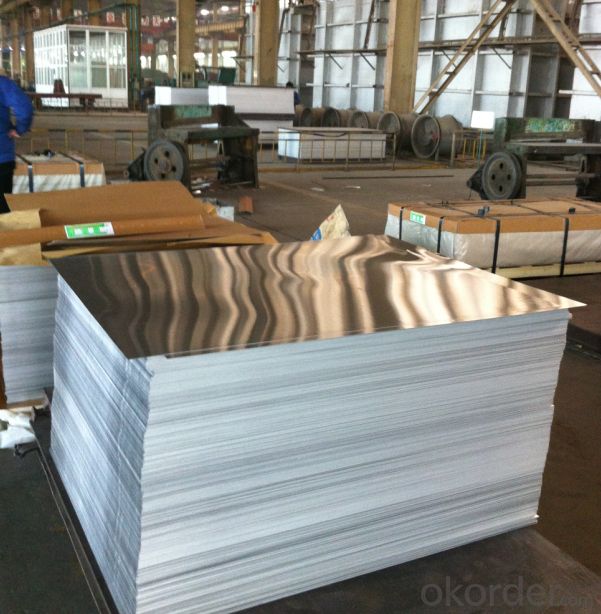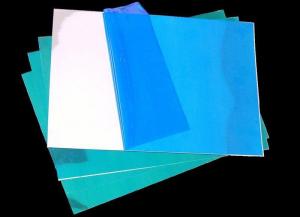1100-H124 aluminium sheet and aluminium slab
- Loading Port:
- Shanghai
- Payment Terms:
- TT OR LC
- Min Order Qty:
- 6 m.t
- Supply Capability:
- 3000 m.t/month
OKorder Service Pledge
OKorder Financial Service
You Might Also Like
1.Structure of Product Description
There are many different grades, such as: 1000 series, 2000 series, 3000 series, 5000 series, 6000series, etc. The detailed grade are as follows: 1010, 1050,1060,1100, 2024, 3003, 3005, 3105, 5052,5754,5083,6061,6063,8011, etc.
The temper is include H14, H22, H24, H44,H112,H114,etc.
2. Main features of the product
a.Competitive price
b.Frist-Class Service.
3. Image.

4. Product detailed sizes:
1219mm*2438mm,1220mm*2440mm,etc.
5. FAQ:
---Usually our standard is GB3880-2006 or others.
What is the width range?
---It is from 1000mm to 2500mm, etc.
What is the length range:
---It is from 2000mm to 6000mm, etc.
- Q:Can 101 aluminum sheets be polished to a mirror-like finish?
- A mirror-like finish can be achieved on 101 aluminum sheets. Aluminum, being a lightweight and highly malleable metal, can be easily polished to obtain a reflective surface. Nevertheless, achieving a mirror-like finish on aluminum requires several steps and the use of appropriate polishing techniques and materials. To achieve a mirror-like finish on aluminum sheets, it is customary to begin by thoroughly cleaning the surface to eliminate any dirt, debris, or oxidation. Following that, sanding the surface with progressively finer sandpaper grits is necessary to eliminate imperfections or scratches. This step is vital in order to create a smooth and uniform surface that can be polished to a high level of shine. Once the sanding is completed, the polishing stage comes into play. There are various methods and materials available for polishing aluminum, such as abrasive compounds, buffing wheels, and polishing pads. These tools are utilized to exert pressure and friction on the aluminum surface, effectively removing any remaining scratches or imperfections and resulting in a smooth, reflective finish. Ultimately, to achieve a genuine mirror-like finish, the process of buffing or burnishing is often employed. This entails applying a polishing compound to the aluminum surface using a soft cloth or a specialized buffing wheel. The compound further refines the surface and enhances its reflective properties, ultimately leading to a mirror-like finish. It is important to note that achieving a mirror-like finish on aluminum can be a time-consuming and labor-intensive process, particularly when dealing with a large quantity of sheets like 101. Additionally, the quality of the aluminum sheets themselves and the skill level of the individual performing the polishing can also impact the final outcome. Nevertheless, with the right materials, techniques, and patience, it is indeed possible to polish 101 aluminum sheets to a mirror-like finish.
- Q:What are the different methods of punching aluminum sheets?
- Various techniques are employed to punch aluminum sheets, each possessing unique advantages and limitations. Presented below are some of the most commonly used methods: 1. Manual Punching: The most fundamental approach involves the use of handheld punch tools to manually create holes or shapes in aluminum sheets. It is suitable for small-scale projects and uncomplicated designs, yet it may be time-consuming and less accurate when compared to alternative methods. 2. Mechanical Punching: Mechanical punching machines utilize a mechanical press equipped with a punch and die set to puncture holes or form shapes in aluminum sheets. Such machines offer higher production rates, improved accuracy, and repeatability. This method is well-suited for medium to large-scale projects. 3. CNC Punching: Computer Numerical Control (CNC) punching machines employ computer programming to control the motion of the punch and die set. This technique enables the creation of intricate shapes, patterns, and multiple holes in a single operation. CNC punching provides exceptional precision, efficiency, and versatility, making it highly sought after in industrial settings. 4. Laser Punching: Laser punching merges laser cutting and punching technologies. A high-powered laser beam heats and softens the aluminum sheet, followed by a mechanical punch that forms the desired hole or shape. Laser punching delivers superior precision, speed, and the capability to work with various materials and thicknesses. It is commonly employed in the automotive and aerospace industries. 5. Waterjet Punching: Waterjet punching involves using a high-pressure stream of water mixed with abrasive substances to cut through aluminum sheets. This method is ideal for cutting intricate shapes and thick materials. It boasts exceptional precision, minimal material distortion, and the ability to work with a diverse range of materials. The choice of punching method depends on factors such as design complexity, required precision, production volume, and budgetary considerations. It is crucial to consider these factors and seek guidance from professionals to determine the most appropriate punching method for a specific application involving aluminum sheets.
- Q:What are the different surface patterns or textures available for aluminum sheets?
- Some of the different surface patterns or textures available for aluminum sheets include smooth, brushed, hammered, embossed, and diamond plate.
- Q:There are about 200 holes on the aluminum plate to be machined. There are 100 M12 thread holes, and the rest are 15MM through holes. The tolerance is +0.02. Seeking detailed processing technology, is the first hole or first processing plane, how to control the amount of deformation of the plate, if the milling process can not guarantee flatness, on the grinder, then the 2 surfaces to stay 2MM margin? Are there any 15MM through holes that can be used to maintain tolerances, or do they need to be boring?. Great God advice, the best detail. Aluminum so much done before, no experience, if it does it scrapped.
- The thickness of 2 to 1. fly in place stress to ensure the flatness of the fitter leveling 0.13 more than the Xicheng pay attention to the protection of the appearance of 4 to ensure the flatness of the fabricated fitter. - this thing must not need to be so high, 100 M12 threaded holes, you still press the map to ensure that ah? Such a large plate deformation, 2 millimeters below the hole can be pressed to do
- Q:what will happen when aluminum sheet is put into copper chloride solution?
- the chemical equation of the reaction, 2Al+3CuCl2=2AlCl3+3Cu, the phenomena when aluminum sheet is put into copper chloride solution: there is red solid generating on the surface of aluminum sheet.
- Q:What is the thickness of an aluminum sheet?
- The specific application and requirements determine the variability in the thickness of an aluminum sheet. A wide variety of thicknesses, usually ranging from 0.006 inches (0.15mm) to 0.25 inches (6.35mm) or even more, can be found in aluminum sheets. Gauge is the usual unit of measurement for thickness, where higher gauge numbers indicate thinner sheets. To choose the right thickness for an aluminum sheet, one must consider the intended use and desired properties like strength, flexibility, or weight.
- Q:What is the classification of 6061106070 aluminum plate, which respectively represent what it means to ask God for help
- The six is the beginning of aluminum silicon alloy is 6061, the United States, 6063, 6082, (a less plate plate is also in many aspects at the beginning of the seven section), is al mg Zn Cu alloy, 7075, 7050, 7475, also belong to the aviation aluminum, also called super hard at the beginning of the eight other series, is currently used in many aspects of the cap, usually thin. As for the number of each brand on behalf of what meaning, I answered another netizen's questions, you know in Baidu search "aluminum plate 1060-H24 what does it mean", you can see my answer
- Q:A 0.2412 gram sample of aluminum ore was dissolved in a dilute mineral acid. The solution was treated with an excess of sodium oxalate. The resultant aluminum oxalate precipitate was filtered, washed and redissolved in mineral acid, then titrated with 42.12 mL of 0.1098 N KMnO4. Calculate the percent of aluminum in the sample.
- 4Al + 6Na2(C2O4) ---- 2Al2(C2O4)3 + 6KMnO4 ---- 3K2(C2O4) Aluminum oxalate and potassium permanganate are at a 1:3 ratio.... Moles of KMnO4 C = 0.1098 mol/L v = 42.12 ml = 0.04212 L C = n/v n= CV = 0.004624776 mols Therefore moles of aluminum oxylate = 0.001541592 mol = moles of aluminum m= 26.98 g/mol * moles mass of aluminum in oxylate = 0.04159215 g % of initial sample = mass of aluminum / mass of ore = 17.24% aluminum in ore sample Perhaps check my math but the method is for sure correct.
- Q:Can aluminum sheets be anodized?
- Yes, aluminum sheets can be anodized. Anodizing is an electrochemical process that creates a durable, corrosion-resistant layer on the surface of aluminum. This process can be applied to aluminum sheets to enhance their appearance, increase their resistance to wear and tear, and improve their overall performance.
- Q:Can aluminum sheets be an alternative to glass in certain applications?
- Certain applications can consider aluminum sheets as an alternative to glass. Aluminum sheets provide various benefits over glass, making them suitable for specific scenarios. To begin with, aluminum sheets possess lightweight and durable characteristics, making them an excellent choice for industries like aerospace or automotive, where weight is a concern. Conversely, glass is relatively heavy and brittle, limiting its usage in certain environments. Moreover, aluminum sheets exhibit exceptional resistance to corrosion, making them a suitable option for marine or coastal applications, where glass may deteriorate over time due to exposure to saltwater. Aluminum sheets also possess a high strength-to-weight ratio, enabling greater design flexibility and structural integrity compared to glass. Furthermore, aluminum sheets offer superior thermal insulation properties in comparison to glass. They provide improved resistance to heat transfer, which is advantageous in applications where temperature control is crucial, like the construction industry. Additionally, aluminum sheets can be more cost-effective than glass in specific applications. The production and installation costs of aluminum sheets are often lower than glass, making them a more economical choice for large-scale projects. However, it is important to acknowledge that glass retains its own unique properties and advantages, such as transparency and optical clarity. Glass also has better resistance to scratches and chemical corrosion when compared to aluminum sheets. In conclusion, while aluminum sheets can serve as a viable alternative to glass in certain applications due to their lightweight, durability, corrosion resistance, thermal insulation properties, and cost-effectiveness, the final decision between the two materials depends on the specific requirements and limitations of the application at hand.
1. Manufacturer Overview |
|
|---|---|
| Location | |
| Year Established | |
| Annual Output Value | |
| Main Markets | |
| Company Certifications | |
2. Manufacturer Certificates |
|
|---|---|
| a) Certification Name | |
| Range | |
| Reference | |
| Validity Period | |
3. Manufacturer Capability |
|
|---|---|
| a)Trade Capacity | |
| Nearest Port | |
| Export Percentage | |
| No.of Employees in Trade Department | |
| Language Spoken: | |
| b)Factory Information | |
| Factory Size: | |
| No. of Production Lines | |
| Contract Manufacturing | |
| Product Price Range | |
Send your message to us
1100-H124 aluminium sheet and aluminium slab
- Loading Port:
- Shanghai
- Payment Terms:
- TT OR LC
- Min Order Qty:
- 6 m.t
- Supply Capability:
- 3000 m.t/month
OKorder Service Pledge
OKorder Financial Service
Similar products
New products
Hot products
Related keywords






























